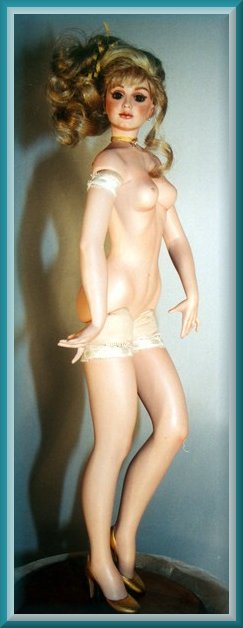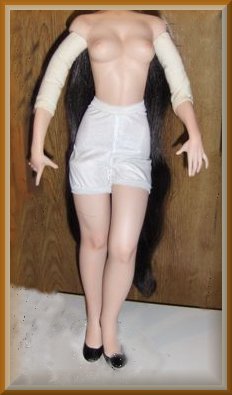REVISED ASSEMBLY INSTRUCTIONS
Doll Artworks 23 inch fashion dolls
GREENWARE PREPARATION
When preparing greenware, cut the leg openings from the buttocks
to the top of the flat area indicated on the torso. Leave the crotch
intact. Cut the arm openings to almost one inch across. You
will need to cut out under the arm into the torso for the straight arms.
Also, if you are the person pouring the doll, it is a good idea to add
a roll of wet clay around the inside of the arms and legs where the groove
line is, while the greenware is still damp. The grooves are shallow
on these dolls, and if you donít make a deep enough groove, the porcelain
wants to slip out of the cloth attachment. If you wish to have the
invisible support, cut a 3/8 inch diameter hole in the sole of the straight
leg.
FABRICS AND SUPPLIES
½ yd. broadcloth----leg/arm tubes
6 inch flexible appliance tubing (half inch exterior measurement)
12 inch long piece of 1/4 inch dowel (or stuffing stick)
tape
Polyfil
Hot glue gun
Two 23 inch lengths of #12 Romex electrical wire
22-gauge floral wire (green wire on paddle)
20mm shoulderplate connector
Felt or mole skin for the head/body contact area
Needle nose pliers
Hemostats (surgical clamping forceps)
BODY CONSTRUCTION
1. Sew 1/4 inch casings on each end of the arm/leg tubes.
2. Fold tubes on the fold line, and sew the tube seam starting
and stopping at the dots.
Backstitch at the beginning and end of
the seams.
3. Turn tubes right side out.
DOLL ASSEMBLY
After setting eyes and lashes, glue a piece of felt or moleskin
to the neck area of the torso, leaving a hole to attach the connector.
Attach head using shoulderplate connector. To do this, run a double
length of dental floss or heavy thread through the loop on the connector;
drop ends of the thread through the top of the head, through the neck,
and down through the torso, exiting through a leg opening. Pull the
threads tight, drawing down the shoulderplate loop. Using the pliers
or hemostat, insert the cotter pin through the armhole into the loop.
Remove cord.
Take the appliance tubing and insert the dowel through it.
This is to keep the tube straight and from getting flattened while stuffing
the leg. Place the tube inside the leg with the hole in the sole,
making sure to keep it centered, and hot glue in place. It
may be easier to run a quantity of hot glue inside the hole from the outside,
and then place the tube in the leg. Allow the tube to protrude
from the sole if the hole is large enough. Keeping the dowel inside
the tube, take one piece of the Romex wire and run it down the leg as far
as it will go. Keeping both tube and wire centered, stuff polyfil
firmly to the top of the leg. Take the second piece of Romex and
insert all the way into the other leg. You will need to bend
it to conform to the leg shape. Keep it centered and stuff firmly
with polyfil. Wrap each leg with bubble wrap or socks to keep them
from banging together while assembling the body. Run a doubled
length of floral wire through each arm and leg casing, leaving enough extra
at each end to make about a half inch long twisted tail when the porcelain
is attached. Attach the legs to the casings, making sure that the
opening in the fabric is to the back of the leg. Twist the wire ends
snuggly, using the needle nose pliers. Cut the twisted end to about
½ inch long and tuck up over the top of the leg. Pull
the body tube up over the wire as far as it will go, and wrap a piece of
tape around it to hold in place while inserting it into the torso.
Insert the Romex from the left leg through the torso and out through the
right armhole. Insert the right leg wire through the torso
and out the left armhole, so that the wires cross inside the torso.
Remove the tape. Insert the arm wire inside each arm as far as it
will go, and check length. The arm should fit the cloth without
being either too tight or too loose. If length is correct, put a
bit of hot glue inside the arm and insert the Romex. Fill remaining
space in the porcelain with polyfil, and then attach the arm to the cloth
tube. Twist the wire and tuck it inside the porcelain like you did
with the legs. Using the stuffing stick or hemostat, stuff
the cloth portion of the arm, down inside the top of the torso as much
as you can. Stuff arms before doing the legs, or it will be
very difficult to do so, especially with the full length arm.
Stitch up the arm opening. Using the hemostat or stuffing tool, push
as much polyfil as you can up into the torso through the leg openings until
the body is firm and the leg openings are full. Stitch up the leg
openings. If there is an unfinished edge where the wire attachment
is, cover with flat ¼ inch lace or other trim. Your doll is
now ready to place on a stand. If there is tubing projecting from
the foot, trim flat with the shoe sole using an exacto knife of other sharp
blade. Wooden stands should be about 8 inches in diameter.
Drill the hole for a ¼ inch dowel. Make it off center so the
doll will be centered on the stand when finished. You can place the
doll on the base to determine where you want her to stand, and mark the
drilling spot with a pencil.
.
These instructions and notes were provided courtesy of Linda
Plaskett of Doll Creations
|

